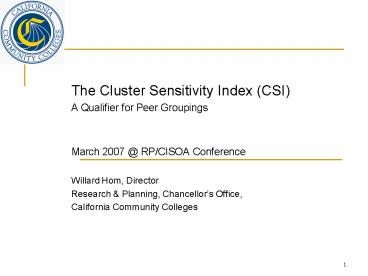The Cluster Sensitivity Index CSI - PowerPoint PPT Presentation
1 / 24
Title:
The Cluster Sensitivity Index CSI
Description:
CSI ... The higher the CSI, the more uncertainty there is for the definition of peer ... The CSI is a tool for evaluating method bias in the classification of a given ... – PowerPoint PPT presentation
Number of Views:57
Avg rating:3.0/5.0
Title: The Cluster Sensitivity Index CSI
1
- The Cluster Sensitivity Index (CSI)
- A Qualifier for Peer Groupings
- March 2007 _at_ RP/CISOA Conference
- Willard Hom, Director
- Research Planning, Chancellors Office,
- California Community Colleges
2
Preface
- Comments about this topic are welcome so that we
can improve our work. - A paper for publication, on this topic, is
forthcoming.
3
Objectives of This Talk
- Propose the CSI as a diagnostic tool for cluster
analyses, esp. in peer grouping. - Propose the weighted peer group mean as a remedy
for certain problems that occasionally arise in
cluster analyses.
4
CSI
- The Cluster Sensitivity Index is a proposed
measure to help analysts understand the usability
of cluster analyses for decision-making. - This is a work in progress.
- Mathemeticians and data-miners have developed
much more sophisticated techniques than the CSI
to make fuzzy clusters but we will not cover
that work here.
5
The Need for the CSI
- Analysts use peer groups for evaluating
institutional situations. - Cluster analysis is often the tool of choice for
defining a peer group. - Cluster analysis has a method bias that can
affect peer group definitions. - We could use a tool to detect this method bias
(or sensitivity to choice of computation).
6
Uses of Peer Grouping
- Higher education.
- California K-12 system.
- Medical care.
- Businesses involved in benchmarking
7
Sources of Method Bias in Cluster Analysis
- Proximity measure Distance (i.e., Euclidean,
etc.) Similarity - Clustering Algorithm (some examples
below) Single Linkage Average
Linkage Wards Other algorithms
8
An Example
- The next slide shows an excerpt of a cluster
analysis to find the peer group for a specific
college (Palomar, by chance). - We ran three different cluster analyses and found
three different peer group definitions for
Palomar. The methods were (1)Avg Linkage
w/Euclidean distance (2) Wards w/ Euclidean
distance and Wards w/Minkowski distance.
9
(No Transcript)
10
Doing the CSI
- Find the smallest peer group for Palomar This is
from Wards Method II. - Find the number of additional institutions that
the other two methods defined as peers to
Palomar. These are Long Beach, East L.A., El
Camino, Sacramento, and Moorpark (5 in count).
11
Doing the CSI, part 2
- Find the number of colleges that the alternate
methods (Avg.Linkage Wards) could have defined
as peers. 108 11 97 - Divide the count of newly found colleges by the
count of potential peers or 5/97. The CSI for
Palomar .052
12
What Does This CSI Mean?
- The peers defined for Palomar are relatively
stable, regardless of which clustering method the
analyst may use. - The mean of this peer group could be a frame of
reference for Palomar, with some standard
precautions.
13
Interpreting the CSI
- The CSI can range from zero to one.
- The higher the CSI, the more uncertainty there is
for the definition of peer members based upon one
clustering method. - Personal levels of risk aversion and future
empirical research would indicate what a given
level of CSI indicates to the analyst.
14
What to Do With a High CSI
- Check your data and data processing/clustering
process for anomalies. - Warn audiences that the cluster results for a
given institution are tenuous. - Produce a summary statistic for the institutions
peer group that adjusts for the fuzziness of
its cluster results.
15
Weighted Peer Group Mean
- Adjusts the peer group mean for the partial
membership (fuzzy membership) of some
institutions. - Accounts for the frequency that an institution is
defined as a peer.
16
Example of Weighted Peer Group Mean
- For the Palomar peer group example, lets compute
this figure for the variable of college age
(years since the college was started).
17
(No Transcript)
18
(No Transcript)
19
(No Transcript)
20
Applications of CSI
- Use when a college needs to know if a peer
grouping from a cluster analysis is sensitive to
the method used (i.e., method bias). - Use if a college has access to the data to run
alternate clusterings with different cluster
methods. (Or have the data owners provide the
alternate outcomes.) - If applied for ARCC peer grouping, ideally, the
System Office should produce the CSI.
21
Some Major Assumptions of CSI
- Cluster analysis (and many classification
methods) will find different peer institutions
for a college if we vary the methods used. - Peer membership can be a fuzzy state.
- The analyst lacks information about the true
clusters in the set of institutions. - The variables used in the cluster analysis are
relevant to the objective and contain valid and
reliable data.
22
More Major Assumptions
- The different methods of clustering or
classification provide equally valid peer
results. (But a random selection of methods could
help in the use of the CSI.) - The population to be peer grouped is relatively
small. - The primary objective is the variability of peer
grouping for a specific college, not the
validation of all peer groups.
23
Summary
- The CSI is a tool for evaluating method bias in
the classification of a given set of data (about
institutions or any entities). - If the CSI causes you concern, you can use the
weighted peer group mean as one remedy. - The CSI can apply to any classification effort
(not just cluster analysis) and to any kind of
population (not just institutions).
24
Contact Info
- Willard Hom, Director/Dean Research Planning
Unit Chancellors Office, California
Community Collegeswhom_at_cccco.edu(916) 327-5887































